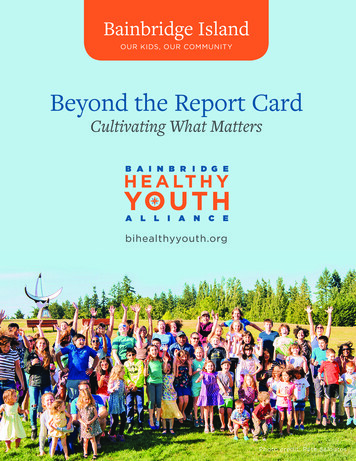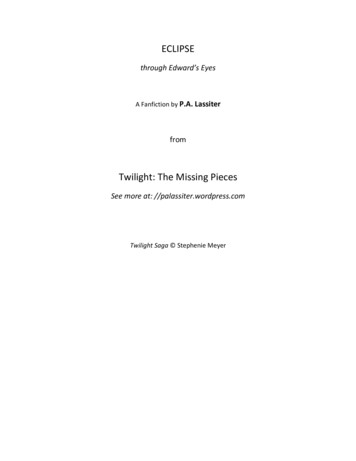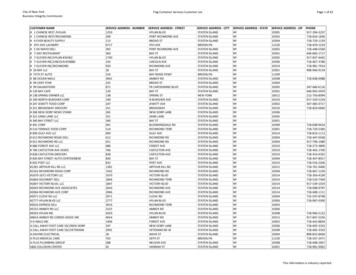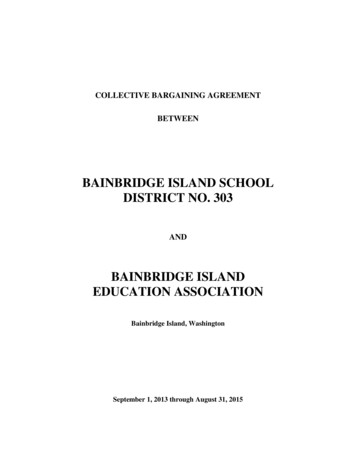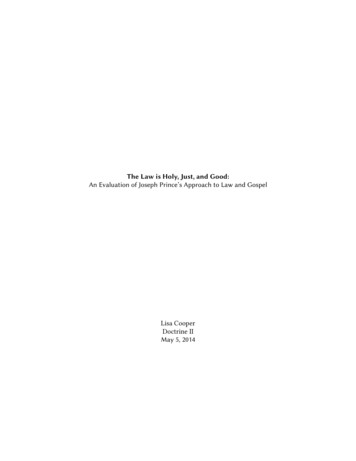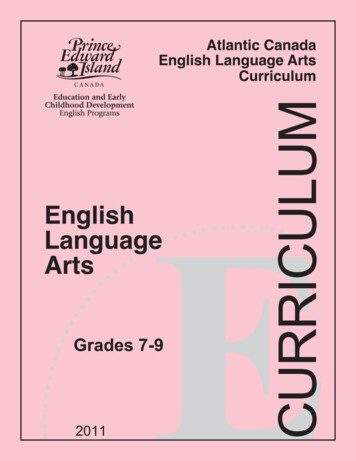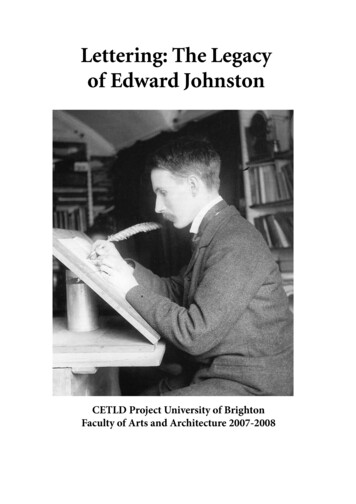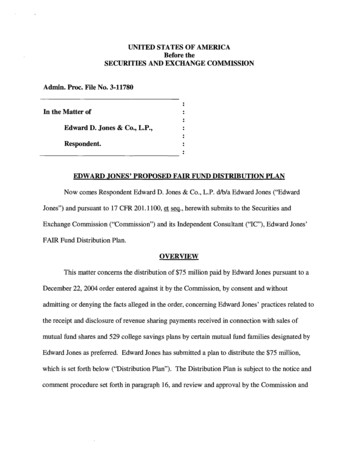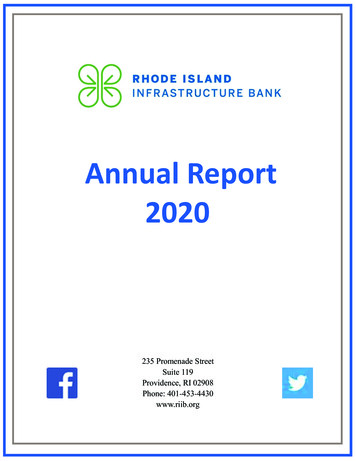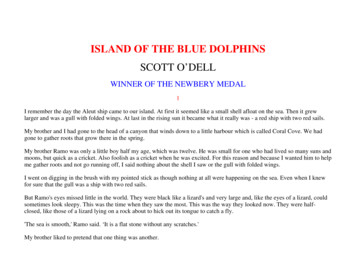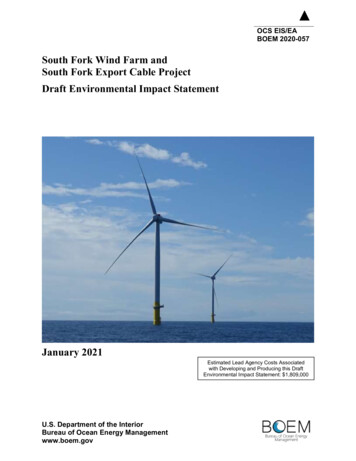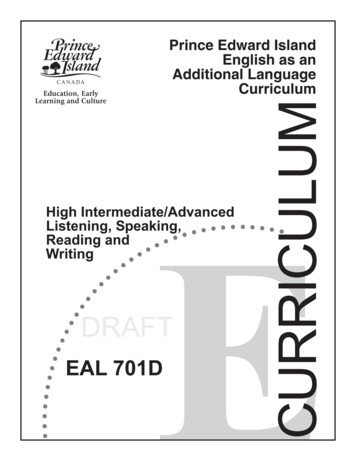
Transcription
EAL 701D:High Intermediate/AdvancedListening, Speaking,Reading and WritingWorking Draft2008Prince Edward IslandEducation and Early Childhood DevelopmentPO Box 2000Charlottetown, Prince Edward IslandCanada, C1A 7N8Tel. (902) 368-4600Fax. (902) 368-4622http://www.gov.pe.ca/educ/
ACKNOWLEDGEMENTSAcknowledgementsThe Prince Edward Island Department of Education and Early ChildhoodDevelopment is gratefully indebted to the departments of education inNewfoundland, Ontario, British Columbia and all other Canadian provinces forthe information they provided and for the use of their English as an additionaland second language curriculum documents which were invaluable in thedevelopment of the Prince Edward Island EAL curriculum.The Department would also like to thank the following committee members forthe contribution and commitment in the development of EAL 701D:Education and EarlyChildhood Development:Vicki Whitlock (EAL Curriculum Specialist)Paula Clark (EAL Assessment Specialist)Shelley Jollimore (EAL Itinerant Teacher)Eastern School District:Oksana Laschuk (EAL Teacher-Colonel Gray)Elizabeth Wendt (EAL Teacher-Colonel Gray)Kathie Kaulbach (Resource Teacher-CharlottetownRural)Western School Board:Jackie Charchuk (Special Education Consultant)EAL 701D: HIGH INTERMEDIATE/ADVANCED LISTENING, SPEAKING, READING AND WRITINGi
EAL 701D: HIGH INTERMEDIATE/ADVANCED LISTENING, SPEAKING, READING AND WRITING
TABLE OF CONTENTSContentsINTRODUCATIONBackground . 1Rationale . 1Purpose of the Curriculum Guide . 2Guiding Principles . 2PROGRAM DESIGNAND COMPONENTSOverview . 4Curriculum Outcomes . 4Essential Graduation Learnings . 4General Curriculum Outcomes . 5Specific Curriculum Outcomes . 6Relevant Research in Language Acquisition . 6Linguistic Processes . 6Language Acquisition . 6BICS to CALP: A Developmental Continuum . 10CONTEXTS FORTEACHING ANDLEARNINGThe EAL 701D Learner . 14Speaking and Listening . 14Reading and Writing . 14Meeting the Needs of All Student . 15Gender Inclusive Curriculum . 15Valuing Social and Cultural Diversity . 16Links to Community . 18Homework . 18The Senior High Learning Environment . 19A Safe Learning Environment . 20Principles Underlying the EAL Curriculum . 21Motivation . 22THE ENGLISH AS ANADDITIONALLANGUAGE LEARNINGENVIRONMENTThe Effective EAL Classroom . 23Literacy and EAL . 26Listening . 27Listening and Note-taking . 30Speaking . 31Pronunciation . 32Integration of Technology in EAL . 35Instructional Approaches and Strategies . 35Introduction . 36ASSESSING ANDEVALUATING STUDENT Assessment/Evaluation Techniques . 37The Language Portfolio . 39LEARNINGStudent Dialogue Journals . 40CURRICULUMOVERVIEWPrior Learning . 41EAL 701D Overview . 41EAL 701D: HIGH INTERMEDIATE/ADVANCED LISTENING, SPEAKING, READING AND WRITINGii
TABLE OF CONTENTSCURRICULUMOUTCOMESGeneral Curriculum Outcomes . 43Specific Curriculum Outcomes . 43CURRICULUM GUIDEORGANIZATIONThe Four-Column Spread . 44Sensitive Topics . 44GCOSCO 1.1 . 46SCO 1.2 . 48SCO 1.3 . 50SCO 1.4 . 52SCO 1.5 . 54SCO 2.1 . 56SCO 2.2 . 58SCO 2.3 . 60SCO 3.1 . 62SCO 3.2 . 64SCO 3.3 . 66SCO 4.1 . 68SCO 4.2 . 70SCO 4.3 . 72SCO 4.4 . 74SCO 4.5 . 76SCO 4.6 . 78SCO 4.7 . 80SCO 5.1 . 82SCO 5.2 . 84SCO 5.3 . 86SCO 5.4 . 88SCO 6.1 . 90SCO 6.2 . 92SCO 6.3 . 94SCO 7.1 . 96SCO 7.2 . 98SCO 7.3 . 100SCO 7.4 . 102SCO 8.1 . 104SCO 8.2 . 106SCO 9.1 . 108SCO 9.2 . 110SCO 9.3 . 112SCO 10.1 . 114SCO 10.2 . 116SCO 10.3 . 118SCO 10.4 . 120SCO 10.5 . 122SCO 10.6 . 124SCI 10.7 . 126iiiEAL 701D: HIGH INTERMEDIATE/ADVANCED LISTENING, SPEAKING, READING AND WRITING
TABLE OF xAppendixAppendixAppendixA: EAL 701D Standards . 129B: Language Reference Chart . 136C: Listening and Speaking . 138D: Reading and Writing . 140E: Checklists . 144F: Rubrics . 146G: Glossary of Terms . 156H: Glossary of Teaching Strategies . 161I: Cultural Awareness/Sensitivity . 163J: Introduction to the Main Resource Text . 164K: Introduction to the Supplementary Resource Text . 168Teacher Resources . 169Student Resources . 169EAL Websites for Teachers and Students . 169References . 171EAL 701D: HIGH INTERMEDIATE/ADVANCED LISTENING, SPEAKING, READING AND WRITINGiv
INTRODUCTIONIntroductionBackgroundCurriculum development is a process that involves many people,much deliberation, discussion, research and time. The developmentof English as an Additional Language (EAL) 701C was based on theneed to support the education of students for whom English is anadditional language in the Prince Edward Island school system.This curriculum document is based on the premises and principlesthat are set out in the Foundation for the Atlantic Canada LanguageArts Curriculum (1999).RationaleEnglish as a Second Language (ESL) refers to learners for whomEnglish is a second language. Although this term is frequently used,this document refers to English language learners as learners forwhom English is an Additional Language (EAL), since English maynot necessarily be a learner’s second language, but rather his/herthird or fourth. For the purpose of clarity and citing pertinentresearch in this area, the term EAL is most applicable (please see theGlossary of Terms, Appendix G).All too often EAL students are assumed to have adequate English tocope with the regular academic program because they have obtainedsome level of oral fluency. Cummins (1979) distinguished betweentwo distinct kinds of language proficiency: Basic InterpersonalCommunicative Skills (BICS) and Cognitive/Academic LanguageProficiency (CALP). It was found that the majority of ESL studentsachieve BICS within two years of residence, but that they achieveCALP only after five to seven years of adequate second-languageinstruction. (Collier 1992; Cummins 1979; Wong-Fillmore 1983).Educating all students is to prepare them for life in the 21stcentury. This includes those learners for whom English is anAdditional Language (EAL). EAL learners bring their cultures,languages and experiences with them when they arrive to Canada.EAL students enrich our society as well as our schools. While theirlinguistic and cultural backgrounds vary greatly, all EAL learnersshare the challenge of adjusting to a new culture and continuingtheir education in their new environment. To realize their neweducational, personal, social and long-term career goals, EAL learnersneed to be able to communicate skillfully, appropriately andeffectively in English. An EAL program which is designed to helpthem specifically address their needs will help them to be able tocommunicate skillfully, appropriately and effectively in English.(Larsen-Freeman 2000; Larsen-Freeman & Long 1991). Based onthe above research, English as an Additional Language (EAL 701C)is developed to directly meet their language and academic learningneeds.EAL 701D: HIGH INTERMEDIATE/ADVANCED LISTENING, SPEAKING, READING AND WRITING1
INTRODUCTIONThe English as an Additional Language (EAL) 701D course is anintroductory/ beginner level language course in listening andspeaking, which is intended to: introduce basic English language skills essential for academicand personal success. provide language instruction to assist learners in furtherdeveloping basic English language skills in reading andwriting. provide guidance and practice for the use of learning strategiesand study skills consistent with successful additional languagelearning. assist students in becoming familiar with strategies, skills andprocedures of the Prince Edward Island school system.Purpose of theCurriculum GuideThe overall purpose of this curriculum guide is to develop EALeducation, teaching and learning, and at the same time, recognizeand validate effective practices in learning English as an additionallanguage that already exist in many classrooms.More specifically, this curriculum guide1.2.3.Guiding Principlesprovides detailed curriculum outcomes to which educatorsand others can refer when making decisions about learningexperiences, instructional techniques, and assessmentstrategies in EAL 701D.informs both educators and members of the general publicabout the philosophy and scope of EAL education for thesenior level in the Atlantic provinces.promotes effective EAL learning and teaching for studentsin the EAL 701D classrooms.Underlying PrinciplesAll kindergarten to senior high curriculum and resources shouldreflect the principles underlying the English Language ArtsCurriculum (1999), which include language being best learned 2as a primary instrument of thought and the most powerfultool students have for developing ideas and insights, forgiving significance to their experiences and for making senseof both their world and their possibilities within itan expression of cultural identitywhen it is integrated; all the language processes areinterrelated and interdependentholistically; students best learn language concepts incontext rather that in isolationthrough purposeful and challenging experiences designedaround stimulating ideas, concepts, issues and themes thatare meaningful to themEAL 701D: HIGH INTERMEDIATE/ADVANCED LISTENING, SPEAKING, READING AND WRITING
INTRODUCTION when students are aware of the strategies and processes theyuse to construct meaning and to solve information-relatedproblemswhen students are given frequent opportunities to assess andevaluate their own learning and performanceas a process of learning where students need various forms offeedback from peers, teachers and others-at school, at homeand in the communitywhen students have opportunities to communicate in variousmodes what they know and are able to dowhen assessment is an integral and ongoing part of thelearning process itself, not limited to final productsMoreover, the underlying principles also include languagelearning as an active process of constructing meaning, drawing on allsources and ways of knowingpersonal and intimately connected to individualitydevelops out of students’ home language and their social andcultural experiencesdevelopmental: students develop flexibility and fluency intheir language use over timecontinual and multi-dimensional; it can best be assessed bythe use of multiple types of evidence that reflect authenticlanguage use over timeEAL 701D: HIGH INTERMEDIATE/ADVANCED LISTENING, SPEAKING, READING AND WRITING3
PROGRAM DESIGN AND COMPONENTSProgram Design and ComponentsOverviewThe EAL 701D curriculum is based on the Foundation for theAtlantic Canada English Language Arts Curriculum (1999) andadapted from the Newfoundland ESL 3205 Course and itscurriculum. The EAL 701D curriculum integrates languagelearning processes, strands and concepts through interactive andcommunicative activities and strategies that have been researched asbest practices in learning English as an additional language.Curriculum OutcomesCurriculum outcomes are statements articulating what students areexpected to know and be able to do in particular subject areas.These outcome statements also describe knowledge and skillsstudents are expected to demonstrate at the end of certain keystages in their education. These are based upon their cumulativelearning experiences at each grade level in the entry-graduationcontinuum.General Curriculum Outcomes (GCOs) are statements articulatingwhat students are expected to know and be able to do uponcompletion of study in a curriculum area.Key-Stage Curriculum Outcomes (KSCOs) are statements thatidentify what students are expected to know and be able to do bythe end of grades 3,6,9, and 12, as a result of their cumulativelearning experience in a curriculum area.Specific Curriculum Outcomes (SCOs) are statements identifyingwhat students are expected to know and be able to do.Essential GraduationLearnings4The Essential Graduation Learnings (EGLs) describe learning interms of knowledge, skills and attitudes. They are consideredessential for all learners graduating from school. The EGLs arecross-curricular and all subject areas contribute to their attainment.The following comprise the EGLs. At high schoolcompletion: Graduates will be able to respond with critical awareness tovarious forms of the arts and be able to express themselvesthrough the arts. Graduates will be able to assess social, cultural, economic andenvironmental interdependence in a local and global context. Graduates will be able to use the listening, viewing, speaking,reading and written modes of language(s) as well asmathematical and scientific concepts and symbols to think,learn and communicate effectively. Graduates will be able to continue to learn and to pursue anactive, healthy lifestyle. Graduates will be able to use the strategies and processesneeded to solve a wide variety of problems, including thoserequiring language, mathematical and scientific concepts.EAL 701D: HIGH INTERMEDIATE/ADVANCED LISTENING, SPEAKING, READING AND WRITING
PROGRAM DESIGN AND COMPONENTS Graduates will be able to use a wide variety of technologies,demonstrate an understanding of technological applications,and apply appropriate technologies for solving problems. Graduates will be able to demonstrate an understanding andappreciation for the place of belief systems in shaping thedevelopment of moral values and ethical conduct.The Essential Graduation Learnings are supported by curriculumoutcomes.General CurriculumOutcomesListening and SpeakingThe general curriculum outcomes for EAL 701D are consistentwith the framework provided by the document Foundation forthe Atlantic Canada English Arts Curriculum (1999).Students will be expected to: speak and listen, to explore, extend, clarify and reflect on theirthoughts, ideas, feelings and experiences. communicate information and ideas effectively and clearly, andto respond personally and critically. interact with sensitivity and respect, considering the situation,audience and purpose.Reading and ViewingStudents will be expected to: select, read and view with understanding a range of literature,information, media and visual arts; interpret, select and combine information using a variety ofstrategies, resources and technologies; respond personally to a range of texts; respond critically to a range of texts, applying their understanding of language, form and genre.Writing and Other Ways of RepresentingStudents will be expected to: use writing and other forms of representation to explore,clarify and reflect on their thoughts, feelings, experiencesand learning; and to use their imagination; create texts collaboratively and independently, using avariety of forms for a range of audiences; use a range of strategies to develop effective writing andmedia products and to enhance their clarity, precision andeffectiveness.EAL 701D: HIGH INTERMEDIATE/ADVANCED LISTENING, SPEAKING, READING AND WRITING5
PROGRAM DESIGN AND COMPONENTSSpecific CurriculumOutcomesThe specific curriculum outcomes (SC0s) for EAL 701D arebased on the specific outcomes from the ESL 3205 CurriculumGuide, NL. They identify what learners are expected to know andbe able to do upon completion of the course. Unit and lessonplanning should be balanced to provide a range of experiencesaddressing each outcome. Instructional practices should bedesigned to provide a variety of opportunities for learners toachieve these outcomes. The specific curriculum outcomesencompass the language strands: reading, viewing, writing andother ways of representing. (for specific 701D SCOs, please seeCurriculum Overview).Relevant Research inLanguage AcquisitionThis section of the curriculum guide is a comprehensive review onthe most relevant research in language acquisition. EAL 701Ddraws heavily on this research, which has serious implications forstudents and teachers.Linguistic ProcessesLinguistic Processes of Language AcquisitionEducators, parents and students have many misconceptions aboutlearning an additional language. Language acquisition consists ofacquiring a language by developing sociocultural, linguistic,academic and cognitive processes. Learning an additional languageis complex and challenging for children, youth and adults.Acquiring an additional language takes a great deal of time, andthe process of learning a language can vary greatly from learner tolearner. The current research has revealed the beneficial role thefirst language plays on the acquisition of the second language. Thecognitive and academic development in a student’s first languagegreatly influences their rate of progression in learning a secondlanguage.Language AcquisitionChildren pass through stages of acquiring their first language-frombabbling to one-word utterances, two-word phrases, full sentences,and eventually, complex grammar (See Chart Below). Studentslearning a second (additional) language also move through thesestages, and they generally proceed from listening and comprehending to speaking, and eventually to reading and writing. The rate oflanguage acquisition is not to be equated with intelligence sincethis rate of acquisition is affected by a multitude of economic,social, personal and circumstantial factors. In order for teachers toeffectively differentiate instruction for these students, they mustknow and understand each stage and its characteristic.Adapted from Classroom Instruction that Works (2006), Hill andFlynn and “English Language Learners; Learning a SecondLanguage” (2007), the Wisconsin Literacy Network and ReadingNetwork Source6EAL 701D: HIGH INTERMEDIATE/ADVANCED LISTENING, SPEAKING, READING AND WRITING
PROGRAM DESIGN AND COMPONENTSStages of Second/Additional Language AcquisitionStageCharacteristicsPreproductionThe student.* has minimalcomprehension* does not verbalize* nods “yes” and “no”* draws and pointsEarlyProductionThe student.* has limitedcomprehension* produces one-or-twoword responses* participates using keywords and familiar phrases* uses present-tense verbsSpeechEmergenceThe student.* has good comprehension* can produce simplesentences* makes grammar andpronunciation errors* frequentlymisunderstands jokesIntermediateFluencyAdvancedFluencyApprox. Time Frame0 - 6 months6 months - 1 yearTeacher PromptsShow me.Where is.Who has.Yes/no questionsEither/or questionsOne-or-two wordanswersListsLabels1 - 3 YearsWhy.?How.?Explain.?Phrase or shortsentence answersThe student.* has excellentcomprehension* makes few grammaticalerrors3 - 5 YearsWhat wouldhappen if.?The student has nearnative level of speech5 - 7 YearsWhy do youthink.?Decide if.Retell.Source: Adapted from Krashen and Terrell (1983).* Please note the rate of production of these stages is affected by literacy in one’s first language (seeLiteracy and EAL).EAL 701D: HIGH INTERMEDIATE/ADVANCED LISTENING, SPEAKING, READING AND WRITING7
PROGRAM DESIGN AND COMPONENTSThe Prism ModelW.P. Thomas & V.P. Collier, 1997icemadAc2 e2vel LopL1mentLanguage Acquisition for SchoolThe model has four major components that“drive” languageacquisition for school: sociocultural, linguistic, academic, andcognitive processes. To understand the interrelationships amongthese four components, Figure 3 symbolizes the developmentalprocess that occurs during the school years for the bilingual child.While this figure looks simple on paper, it is important toimagine that this is a multifaceted prism with many dimensions.The four major components—sociocultural, linguistic, academic,and cognitive processes—are interdependent and complex.L1 L2 Cognitive DevelopmentInterdependence of the Four ComponentsAll of these four components—sociocultural, academic, cognitive,and linguistic—are interdependent. If one is developed to theneglect of another, this may be detrimental to a student’s overallgrowth and future success. The academic, cognitive, and linguisticcomponents must be viewed as developmental. For the child,adolescent, and young adult still going through the process offormal schooling, development of any one of these threecomponents depends critically on simultaneous development ofthe other two, through both first and second languages. Sociocultural processes strongly influence, in both positive and negativeways, students’ access to cognitive, academic, and languagedevelopment. It is crucial that educators provide a socioculturally8EAL 701D: HIGH INTERMEDIATE/ADVANCED LISTENING, SPEAKING, READING AND WRITING
PROGRAM DESIGN AND COMPONENTSsupportive school environment that allows natural language,academic, and cognitive development to flourish in both L1 andL2 (Collier, 1995a, 1995c, Thomas and Collier, 2002).Language Acquisition and Social LanguageBICS- Basic Interpersonal Communicative Skills (BICS): “Conversational English/Social Language; the language ofnormal everyday speech, including pronunciation, grammar,and basic vocabulary. BICS represent the ability to understandand speak informally with friends, teachers and parents; theaspects of communication that are used daily in routinecommunicative exchanges (e.g. while dressing, eating, bathing,playing, etc.). In addition to showing the informal aspects ofsocial talk, BICS also reveal the skills that do not require ahigh degree of cognition (e.g. naming objects and actions,referring to non-existence, disappearance, rejection, andnegation, and so forth). Students demo
English as a Second Language (ESL) refers to learners for whom English is a second language. Although this term is frequently used, this document refers to English language learners as learners for whom English is an Additional Language (EAL), since English may not necessarily be a learn
